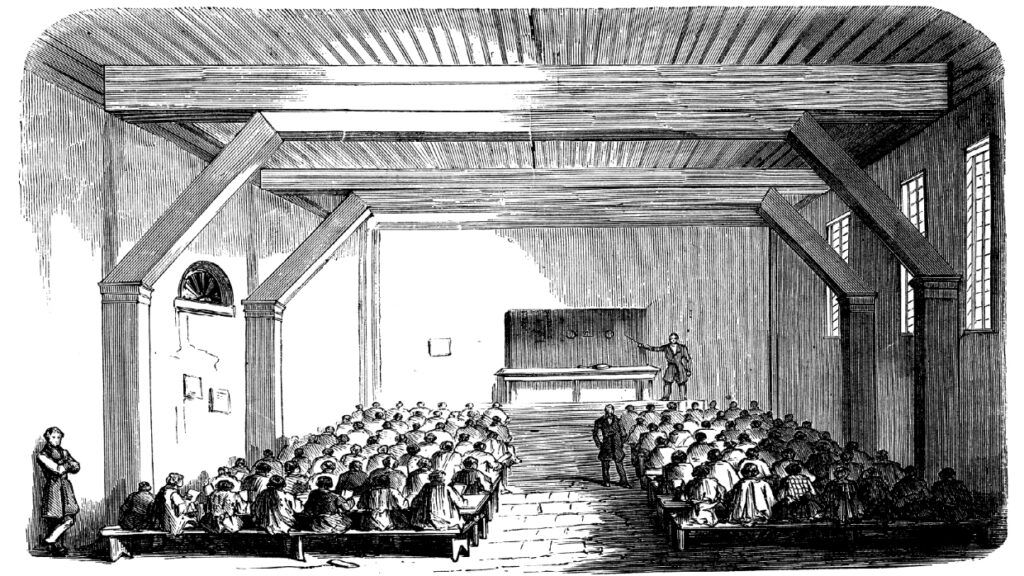Learning and development has changed greatly in recent decades, but the changes that have taken place recently are nothing compared to the drastic advancements that have occurred since the galvanising power of the industrial revolution in the 19th Century. Prior to this, few industries had even considered the possibility of professional development, and yet the progress that has been made since this time is astounding. In this series of features we want to celebrate the momentous transformation that has occurred in the field of L&D, leading to the amazing learning opportunities we have today.
19th Century
The major driving force for L&D in the 19th century was the industrial revolution. There was significant concern that Britain’s labour force was under-skilled compared with other nations, encouraging a push to develop in the industrial sectors. Furthermore, with a growing number of manufacturing processes becoming mechanised and a wide range of new service-based professions (e.g. lawyers and accountants) emerging, this sparked the need for more qualified people to take on these roles. To combat these issues there was a move towards specific workplace training to ensure workers had the skills necessary to embrace the latest developments in these emerging sectors. This emphasis on workplace training would be a common trend throughout the 20th century as new trades continued to surface.
The First World War
With the dawn of the First World War, the primary focus became the manufacturing of munitions – these needed to be produced as quickly as possible on a large scale. This required a huge increase in the number of people working to create weapons, and lead the Ministry of Munitions to develop training schemes that would enable a significant growth in the workforce as quickly as possible. Similarly, advanced training schemes were introduced for new recruits to the armed forces, many of whom attended accelerated programmes compared to the typical pathway. In addition to this, the loss of many working age men to the frontline also necessitated the introduction of women into a variety of roles. Due to the relatively small proportion of women who worked prior to this, (and often in significantly different occupations), many industries had to provide training for their new female employees to ensure ongoing success to support the war effort.
1917
After the war ended there was an effort to return to a ‘normal’ way of life, but unfortunately due to their experiences during the war and the injuries many of them sustained, there were significant numbers of ex-servicemen who were unable to return to their pre-war roles. While women continued to contribute to the workforce, there was a new focus on offering assistance to ex-servicemen to help them return to employment. The King’s National Roll was a programme intended to help retrain men who had returned from war, and guaranteed them employment in a suitable role. It was a significant stepping stone towards a new way of using training to help people migrate between different roles, and although used for ex-servicemen in this case, set the stage for new learning initiatives in the future.
1925
In addition to the King’s National Roll, in 1925 there was another post-war initiative aimed at helping ex-servicemen in particular, return to employment. The Interrupted Apprenticeship Scheme was launched to enable enlisted men to resume their pre-war apprenticeships. It is estimated that approximately 100,000 men successfully completed their training as a result of the initiative. In addition, the shift in focus during the war had led to a significant imbalance between the skills of the workforce; in particular there was a noticeable decrease in numbers of skilled workers compared with manual workers.
Training strategies were thus launched to increase the levels of skilled workers and reinvigorate the sectors that had suffered during the war. There was also a focus on helping redeploy women in the workplace as many of the roles they had occupied during the war were reassigned to the men who had returned home, and notable efforts were made to train women in the skills needed for domestic jobs.
1945
With the end of the Second World War looming, large scale destruction was once again a serious issue in Britain. Efforts were consequently focused on training up a skilled labour and construction workforce who could aid in the reconstruction and development of post-war Britain. It was a particularly difficult time due to the significant amount of debt Britain incurred due to efforts to keep the country stable; however the investment in job creation and training enabled Britain to rebalance the economy and went on to promote substantial growth.
In the next instalment of this series, I will look at the evolution of L&D practices between 1950 and 1990.
Learning and development has changed greatly in recent decades, but the changes that have taken place recently are nothing compared to the drastic advancements that have occurred since the galvanising power of the industrial revolution in the 19th Century. Prior to this, few industries had even considered the possibility of professional development, and yet the progress that has been made since this time is astounding. In this series of features we want to celebrate the momentous transformation that has occurred in the field of L&D, leading to the amazing learning opportunities we have today.
19th Century
The major driving force for L&D in the 19th century was the industrial revolution. There was significant concern that Britain’s labour force was under-skilled compared with other nations, encouraging a push to develop in the industrial sectors. Furthermore, with a growing number of manufacturing processes becoming mechanised and a wide range of new service-based professions (e.g. lawyers and accountants) emerging, this sparked the need for more qualified people to take on these roles. To combat these issues there was a move towards specific workplace training to ensure workers had the skills necessary to embrace the latest developments in these emerging sectors. This emphasis on workplace training would be a common trend throughout the 20th century as new trades continued to surface.
The First World War
With the dawn of the First World War, the primary focus became the manufacturing of munitions - these needed to be produced as quickly as possible on a large scale. This required a huge increase in the number of people working to create weapons, and lead the Ministry of Munitions to develop training schemes that would enable a significant growth in the workforce as quickly as possible. Similarly, advanced training schemes were introduced for new recruits to the armed forces, many of whom attended accelerated programmes compared to the typical pathway. In addition to this, the loss of many working age men to the frontline also necessitated the introduction of women into a variety of roles. Due to the relatively small proportion of women who worked prior to this, (and often in significantly different occupations), many industries had to provide training for their new female employees to ensure ongoing success to support the war effort.
1917
After the war ended there was an effort to return to a 'normal' way of life, but unfortunately due to their experiences during the war and the injuries many of them sustained, there were significant numbers of ex-servicemen who were unable to return to their pre-war roles. While women continued to contribute to the workforce, there was a new focus on offering assistance to ex-servicemen to help them return to employment. The King’s National Roll was a programme intended to help retrain men who had returned from war, and guaranteed them employment in a suitable role. It was a significant stepping stone towards a new way of using training to help people migrate between different roles, and although used for ex-servicemen in this case, set the stage for new learning initiatives in the future.
1925
In addition to the King’s National Roll, in 1925 there was another post-war initiative aimed at helping ex-servicemen in particular, return to employment. The Interrupted Apprenticeship Scheme was launched to enable enlisted men to resume their pre-war apprenticeships. It is estimated that approximately 100,000 men successfully completed their training as a result of the initiative. In addition, the shift in focus during the war had led to a significant imbalance between the skills of the workforce; in particular there was a noticeable decrease in numbers of skilled workers compared with manual workers.
Training strategies were thus launched to increase the levels of skilled workers and reinvigorate the sectors that had suffered during the war. There was also a focus on helping redeploy women in the workplace as many of the roles they had occupied during the war were reassigned to the men who had returned home, and notable efforts were made to train women in the skills needed for domestic jobs.
1945
With the end of the Second World War looming, large scale destruction was once again a serious issue in Britain. Efforts were consequently focused on training up a skilled labour and construction workforce who could aid in the reconstruction and development of post-war Britain. It was a particularly difficult time due to the significant amount of debt Britain incurred due to efforts to keep the country stable; however the investment in job creation and training enabled Britain to rebalance the economy and went on to promote substantial growth.
In the next instalment of this series, I will look at the evolution of L&D practices between 1950 and 1990.







